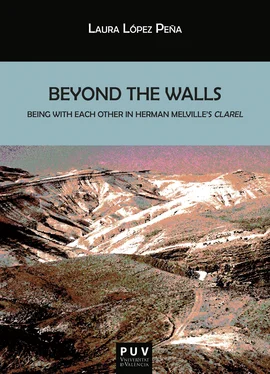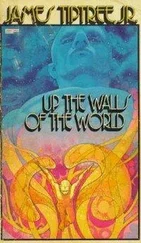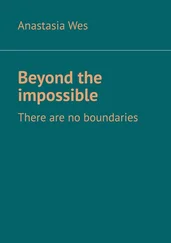Laura López Peña - Beyond the Walls.
Здесь есть возможность читать онлайн «Laura López Peña - Beyond the Walls.» — ознакомительный отрывок электронной книги совершенно бесплатно, а после прочтения отрывка купить полную версию. В некоторых случаях можно слушать аудио, скачать через торрент в формате fb2 и присутствует краткое содержание. Жанр: unrecognised, на английском языке. Описание произведения, (предисловие) а так же отзывы посетителей доступны на портале библиотеки ЛибКат.
- Название:Beyond the Walls.
- Автор:
- Жанр:
- Год:неизвестен
- ISBN:нет данных
- Рейтинг книги:3 / 5. Голосов: 1
-
Избранное:Добавить в избранное
- Отзывы:
-
Ваша оценка:
- 60
- 1
- 2
- 3
- 4
- 5
Beyond the Walls.: краткое содержание, описание и аннотация
Предлагаем к чтению аннотацию, описание, краткое содержание или предисловие (зависит от того, что написал сам автор книги «Beyond the Walls.»). Если вы не нашли необходимую информацию о книге — напишите в комментариях, мы постараемся отыскать её.
Beyond the Walls. — читать онлайн ознакомительный отрывок
Ниже представлен текст книги, разбитый по страницам. Система сохранения места последней прочитанной страницы, позволяет с удобством читать онлайн бесплатно книгу «Beyond the Walls.», без необходимости каждый раз заново искать на чём Вы остановились. Поставьте закладку, и сможете в любой момент перейти на страницу, на которой закончили чтение.
Интервал:
Закладка:
It is only through sharing—both of a physical space (a room and a bed) and of their respective beings and cultural practices (Ishmael joins Queequeg in his prayers to the little idol Yojo, while Queequeg attends with Ishmael the Bethel where Father Mapple delivers his sermon)—by means of constant interaction (verbal and non-verbal, for Queequeg communicates with Ishmael through gestures and sentences in broken English), that the bond between Ishmael and Queequeg is developed. This intersubjective union is eventually materialized in the symbolic wedding of the two men’s hearts, which has the power of giving peace to both Ishmael and Queequeg, and of stretching their thinking parameters in order to encompass those thinking paramenters of the other as well. Even though this study shall analyze particular instances of intersubjectivity, and of the failure of intersubjectivity, in the 1876 Clarel in future chapters, I find it important to anticipate at this point a Melvillean instance of intersubjectivity that may better enable an understanding of the ways the present volume appropriates the concept in its theoretical articulation of Melville’s intersubjective universalism. What derives from the previous Moby-Dick example, thus, is a conception of intersubjectivity which implies neither the fusion of individuals nor the colonial act of appropriating the other and neutralizing his or her difference so as to make the other less strange, and therefore less different, to ourselves. In a way similar to the Derridean notion of hospitality, intersubjectivity does not assimilate the other in one’s space but opens up one’s space to incorporate the other as other. Similarly, Martin Buber uses the image of the double cry to illustrate his understanding of intersubjectivity. The philosopher describes two cries that (cor)respond to each other, modifying one another yet without merging into an identical voice:
But then, somewhere, far away, another cry moves towards me, another which is the same, the same cry uttered or sung by another voice. Yet it is not the same cry, certainly no “echo” of my cry but rather its true rejoinder, tone for tone not repeating mine, not even in a weakened form, but corresponding to mine, answering its tones—so much so, that mine, which at first had to my own ear no sound or questioning at all, now appears as questions, as a long series of questions, which now all receive a response. The response is no more capable of interpretation than the question. And yet the cries that meet the one cry that is the same do not seem to be the same as one another. Each time the voice is new. (“Nature” 42)
Buber notes that intersubjectivity does not always necessitate language to become possible: “If I were to report with what I heard it [the cry] I should have to say ‘with every pore of my body’” (43).
Another important theorization of subjectivity as intersubjectivity is Jean-Luc Nancy’s conception of Being as being-with. Moving away from the notion of community, which the philosopher himself had contributed to articulate in earlier works such as The Inoperative Community (1983), in the 1996 Being Singular Plural , Nancy theorizes a relational ontology: he argues that meaning is the very sharing of Being, and Being—and therefore meaning—is nothing but being with others. Consequently, Nancy explains, Meaning is not communicated but “put into play” (27) as and in the “with” of Being; it is exposed and reformulated through the act of dialogue every time Being is enacted and shared. Nancy’s relational conception of existence is enabling to rethinking interpersonal relationships, interpersonal bonds, and interpersonal responsibility beyond egocentrisms and communitarian forms of identification, including nationality and the nation-state. Nancy’s being-with may also be connected to Agamben’s concept of the “coming community” formed by “whatever singularities” that constitute enemies of the State due to their rejection of identity and of traditional forms of belonging. According to this, Agamben develops the notion of adjacency, which the philosopher defines as “ exiling oneself to the other as he or she is ” (23). This is disruptive of conceptions of a common identity and sameness upon which communities have traditionally been built. Agamben’s adjacency might be taken as equivalent to Nancy’s being-with as well as to Derrida’s hospitality, in that it constitutes an intersubjective space of possibility by which different singularities make contact with one another, without affirming an identity. The potentiality of this exile into, or reception of, the other may be a development of a sense of belonging together beyond identities or communities, which opens up new relational spaces and possibilities for plural thinking. In a darker light, however, intersubjective contact may also lead to violent consequences when such openness to the other is not produced.
Similarly to Nancy, Agamben, and Derrida, Martin Buber has theorized a conception of community that turns away from identitarian and community-based models. This philosopher argues that community not only encloses and contains the existence of each individual within that of the group, but also hinders individual relationships among its members, even suppressing the personal for the collective (“Social” 68). Instead, Buber locates community not in a uniting feature but in the communal disposition of the individual: “a people is community to the extent that it is communally disposed” (“Community” 99). It is, therefore, in this communal disposition, in the interpersonal or intersubjective, that bonds may be formed between people, without limiting such bonds to identitarian commonalities or questions of sameness. Buber’s notion of community understood as communal disposition facilitates the conception of universalism as a process grounded on the very plurality by which it is constituted. This plural universalism is created intersubjectively, as individuals who are necessarily different (not only because they are representative of certain racial, ethnic, national, religious, sexual, identities, but because they constitute complex subjectivities, inevitably different from one another) negotiate meanings by means of dialogic encounters. The positive potentiality of this dialogic process is abridging inter-human divisions posed by the nation-state and other forms of communitarian affiliation that obscure human connectedness and pose inter-personal walls as natural. This dialogic process may also enable the potentiality for global spaces that are more ethically and politically democratic than community-based ones.
As S. N. Eisenstadt has noted, intersubjectivity is rooted in social interaction and a continuous dialogue (27) by which meaning may be seeked out, explored, challenged, deconstructed, made anew. According to Hannah Arendt, dialogue is the instrument through which human beings make sense of their experiences of the world to others: “whatever men do or know or experience can make sense only to the extent that it can be spoken about. […] Men in the plural, that is, men in so far as they live and move and act in this world, can experience meaningfulness only because they can talk with and make sense to each other and to themselves” ( Human 4). It is also the instrument by which human beings make sense of their experience of the world to themselves, since Arendt also emphasizes the “being-with-myself” that takes places within the individual, which she names “solitude”:
To be with myself and to judge by myself is articulated and actualized in the processes of thought, and every thought process is an activity in which I speak with myself about whatever happens to concern me. The mode of existence present in this silent dialogue of myself with myself, I now shall call solitude . Hence, solitude is more than, and different from, other modes of being alone, particularly and most importantly loneliness and isolation. Solitude means that though alone, I am together with somebody (myself, that is). It means that I am two-in-one, whereas loneliness as well as isolation do not know this kind of schism, this inner dichotomy in which I can ask questions of myself and receive answers. (“Some Questions” 97-98)
Читать дальшеИнтервал:
Закладка:
Похожие книги на «Beyond the Walls.»
Представляем Вашему вниманию похожие книги на «Beyond the Walls.» списком для выбора. Мы отобрали схожую по названию и смыслу литературу в надежде предоставить читателям больше вариантов отыскать новые, интересные, ещё непрочитанные произведения.
Обсуждение, отзывы о книге «Beyond the Walls.» и просто собственные мнения читателей. Оставьте ваши комментарии, напишите, что Вы думаете о произведении, его смысле или главных героях. Укажите что конкретно понравилось, а что нет, и почему Вы так считаете.










